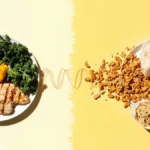For years, Sarah, a dedicated marathon runner and new mother, found herself battling persistent fatigue, anemia, and frustrating sugar crashes. Her doctor, recognizing her active lifestyle and desire for plant-based nutrition, recommended integrating more nutrient-dense foods, particularly quinoa, into her diet. She started experimenting, crafting vibrant salads with roasted vegetables and chickpeas, and even a hearty breakfast porridge. Within a few months, the change was profound: her energy levels stabilized, her hemoglobin improved, and the mid-afternoon slump became a distant memory. “Quinoa became my secret weapon,” she recounts. “It’s incredibly filling, versatile, and doesn’t leave me feeling heavy, making it perfect for both daily fuel and sustained training.” This ancient supergrain, once a sacred staple of the Incas, offers a remarkable array of health benefits and uses that can transform your dietary landscape. Join us as we explore the profound impact quinoa can have on your wellness journey.
Discovering Quinoa: An Ancient Grain for Modern Nutrition
The story of quinoa is one of remarkable resilience and rediscovered nutritional wisdom. Originating in the Andean region thousands of years ago, this humble seed has transcended its indigenous roots to become a global culinary phenomenon. Its journey from a sacred Incan crop to a modern superfood highlights a growing appreciation for traditional foods that offer exceptional health benefits and environmental adaptability. Understanding its origins and unique characteristics is the first step toward harnessing its full potential.
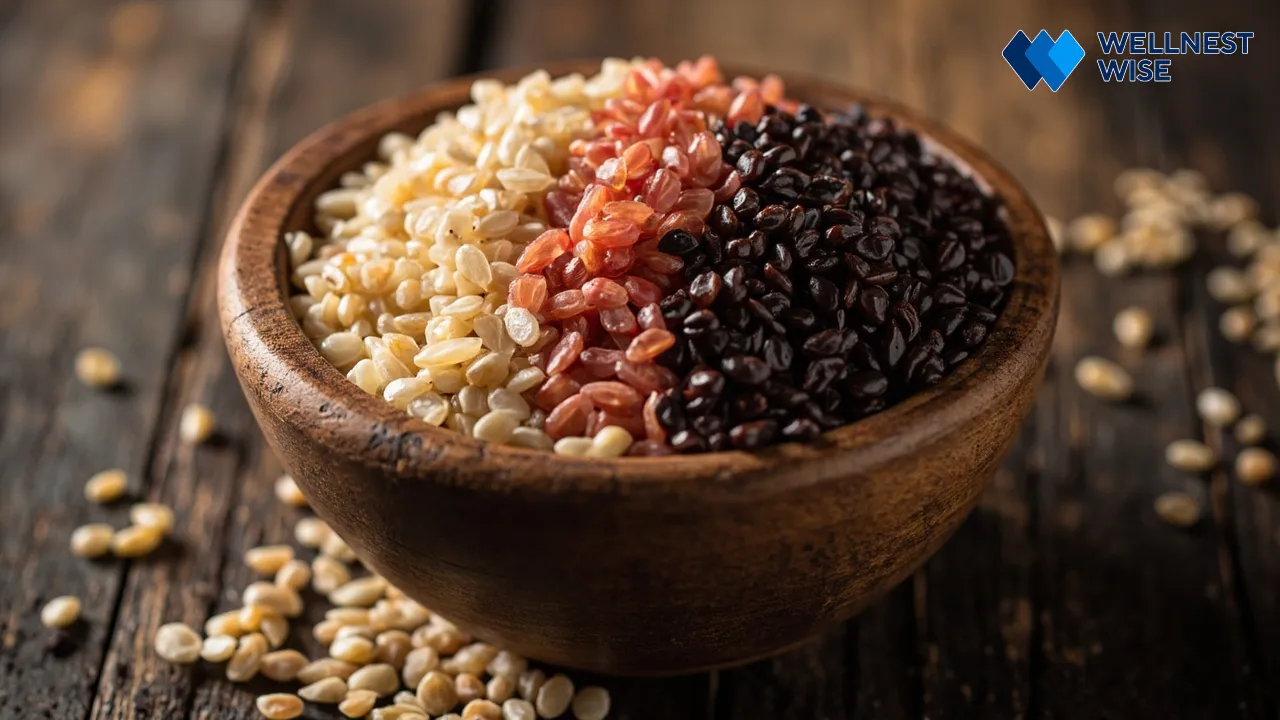
What is Quinoa? Defining the Nutritious Pseudocereal
Despite often being referred to as a grain, quinoa (pronounced KEEN-wah) is botanically classified as a pseudocereal. This means it’s a non-grass plant that produces seeds or fruits used in the same way as cereals, but it doesn’t belong to the grass family (Poaceae) like wheat, rice, or corn. Its unique classification contributes to its gluten-free nature and distinct nutritional profile. Quinoa seeds are rich in protein, dietary fiber, and essential minerals, distinguishing it from conventional grains and solidifying its reputation as a uniquely nutritious pseudocereal [1].
A Brief History of Quinoa: From Andean Staple to Global Superfood
The history of quinoa is deeply intertwined with the ancient civilizations of the Andes, particularly the Inca Empire, where it was revered as “the mother of all grains” (chisaya mama) and considered sacred. For centuries, it served as a primary food source, providing vital sustenance in harsh, high-altitude environments. Fast forward to the 21st century, and quinoa has experienced a dramatic resurgence, celebrated globally as a superfood. This renewed interest culminated in the United Nations Food and Agriculture Organization (FAO) declaring 2013 the “International Year of Quinoa,” highlighting its potential to contribute to global food security and nutrition due to its remarkable adaptability and complete nutritional package [3].
Understanding Different Quinoa Varieties and Their Characteristics
While quinoa is predominantly known for its small, round seeds, it actually comes in several varieties, each with subtle differences in flavor, texture, and cooking time. The most common types you’ll encounter are:
- White Quinoa: The most popular variety, it has the mildest flavor and the fluffiest texture when cooked. It’s ideal for salads, side dishes, and general cooking.
- Red Quinoa: This variety holds its shape better after cooking, offering a slightly chewier texture and a richer, nuttier flavor. It’s excellent for cold salads where a firmer grain is desired.
- Black Quinoa: The darkest and often the chewiest of the three, black quinoa boasts an earthy, slightly sweeter flavor. Its striking color adds visual appeal to dishes.
All varieties offer similar comprehensive nutritional benefits, making the choice largely a matter of culinary preference.
Unpacking Quinoa’s Nutritional Powerhouse: Facts and Figures
Understanding the quinoa nutrition facts reveals why this pseudocereal has earned its revered status. It’s not just a carbohydrate source; it’s a complete package of protein, fiber, vitamins, and minerals that can significantly enhance dietary quality. Delving into its precise composition provides a clear picture of how quinoa contributes to overall health and why it’s a superior choice for many compared to more common grains. Let’s break down the components that make it a true nutritional powerhouse.
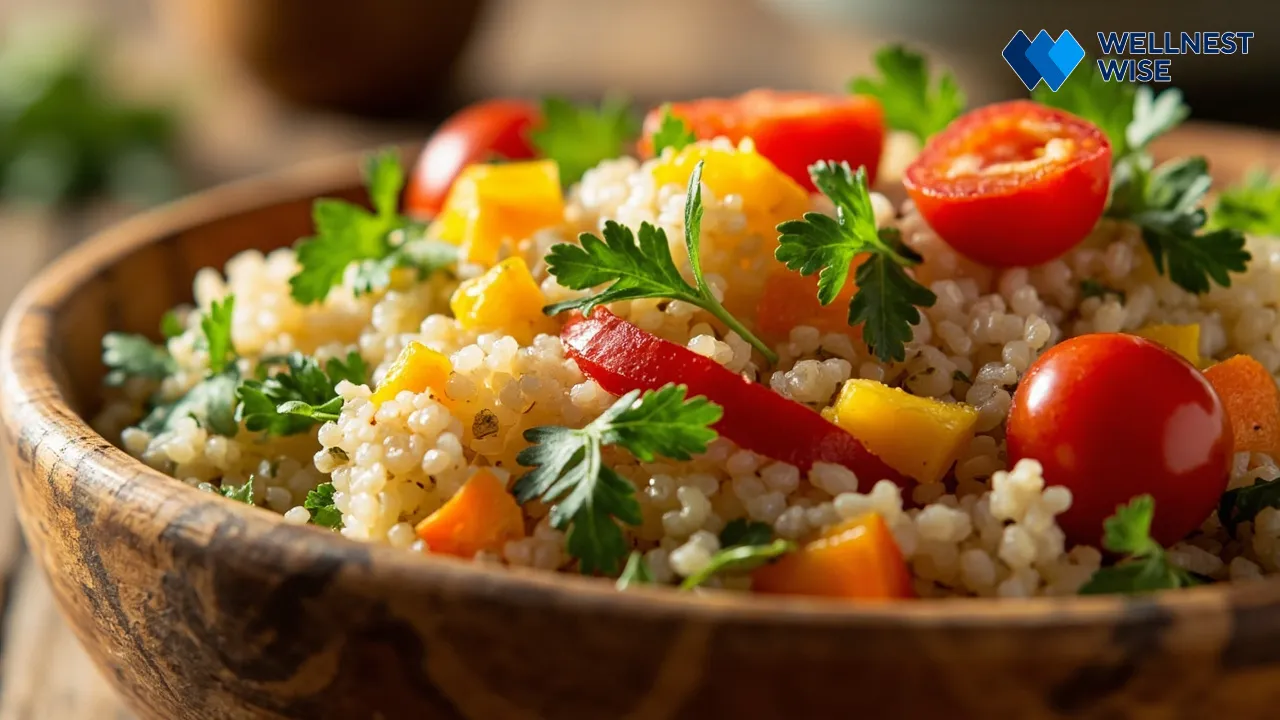
Quinoa Nutrition Facts: A Detailed Breakdown per Serving
Below is a detailed look at the typical nutritional values for 100 grams of cooked quinoa, providing a clear snapshot of its impressive profile [1, 2]:
| Nutrient | Amount (per 100g cooked quinoa) | Daily Value (approx.) | Key Benefit |
|---|---|---|---|
| :————— | :—————————— | :——————– | :——————————————— |
| Calories | 120 kcal | 6% | Energy source |
| Protein | 4.4 g | 9% | Muscle repair, satiety |
| Carbohydrates | 21.3 g | 7% | Primary energy |
| Dietary Fiber | 2.8 g | 10% | Digestive health, blood sugar control |
| Fats | 1.9 g | 2% | Essential fatty acids (low saturated fat) |
| Saturated Fat | 0.2 g | 1% | |
| Unsaturated Fat | 1.5 g | ||
| Magnesium | 64 mg | 15% | Nerve & muscle function, bone health |
| Iron | 1.5 mg | 8% | Oxygen transport, energy |
| Zinc | 1.1 mg | 10% | Immune function, wound healing |
| B Vitamins | (Various) | Varies | Metabolism, energy production (e.g., Folate) |
The Power of Complete Protein: Quinoa’s Essential Amino Acid Profile
One of quinoa’s most celebrated attributes is its status as a complete protein. This means it contains all nine essential amino acids that the human body cannot produce on its own and must obtain from food [1]. While many plant-based protein sources are incomplete (lacking one or more essential amino acids), quinoa stands out, offering a robust amino acid profile that includes crucial components like lysine and methionine, often sparse in other grains. This makes it an invaluable food for vegetarians, vegans, and anyone looking to boost their protein intake with high-quality plant-based options, supporting muscle maintenance, repair, and overall metabolic function [2].
Fiber-Rich Goodness: How Dietary Fiber in Quinoa Supports Digestive Health
Quinoa is an excellent source of dietary fiber, providing a significant amount of both soluble and insoluble fiber. This fiber-rich goodness plays a crucial role in maintaining optimal digestive health. Insoluble fiber adds bulk to stool, promoting regular bowel movements and preventing constipation, while soluble fiber forms a gel-like substance in the digestive tract, which can help regulate blood sugar levels and lower cholesterol. This synergistic action not only supports a healthy gut microbiome but also contributes to feelings of satiety, making it a valuable ally for managing appetite and promoting overall gastrointestinal well-being [1].
Beyond the Basics: Key Vitamins, Minerals, and Antioxidants in Quinoa
While its protein and fiber content often steal the spotlight, quinoa also boasts an impressive array of vitamins, minerals, and powerful antioxidants. These micronutrients are vital for countless bodily functions, from energy production to cellular protection, cementing quinoa’s reputation as a truly nutrient-dense food.
Magnesium and Iron: Vital Minerals for Energy and Overall Well-being
Quinoa is particularly rich in magnesium and iron, two minerals critical for maintaining energy and overall well-being. Magnesium is involved in over 300 enzymatic reactions in the body, supporting nerve and muscle function, blood glucose control, and bone health. Adequate magnesium intake can also help reduce feelings of fatigue. Iron, on the other hand, is essential for the formation of hemoglobin, which carries oxygen in the blood, preventing anemia and ensuring that cells receive the oxygen they need to function efficiently. The plant-based iron in quinoa is well-absorbed, particularly when consumed with vitamin C-rich foods [1].
Quercetin and Kaempferol: Antioxidant Compounds for Cellular Protection
Beyond its fundamental vitamins and minerals, quinoa contains potent plant compounds known as antioxidants, including quercetin and kaempferol. These flavonoids are powerful natural compounds that help protect the body’s cells from damage caused by free radicals, which are unstable molecules linked to chronic diseases and aging. Research indicates that the antioxidant activity of quinoa rivals that of many berries and vegetables. By combating oxidative stress, these compounds contribute significantly to cellular protection and may play a role in reducing the risk of inflammation and various health conditions [1].
The Holistic Health Benefits of Integrating Quinoa into Your Diet
Embracing quinoa in your daily meals extends beyond just adding a nutritious food; it’s about investing in your holistic health. Its unique composition works synergistically to deliver a wide spectrum of benefits, touching everything from your digestive system to your heart, and even aiding in weight management. This versatile pseudocereal offers a multifaceted approach to wellness, making it a smart choice for anyone looking to optimize their dietary intake. Let’s explore the transformative health benefits of this ancient grain.

Optimizing Digestive Health with Quinoa’s Soluble and Insoluble Fiber
The robust dietary fiber content in quinoa, comprising both soluble and insoluble types, is a cornerstone for optimizing digestive health. Insoluble fiber acts like a broom, sweeping through the digestive tract, promoting regular bowel movements, and preventing constipation. Soluble fiber, however, dissolves in water to form a gel-like substance, which can help soften stool and feed beneficial gut bacteria, acting as a prebiotic. This dual action supports a balanced gut microbiome, reduces the risk of digestive discomfort, and fosters overall gut wellness, making quinoa an excellent choice for maintaining a healthy digestive system [1].
Stabilizing Blood Sugar Levels: The Low Glycemic Index Advantage of Quinoa
For those mindful of blood sugar levels, quinoa offers a significant advantage with its relatively low glycemic index (GI). Foods with a low GI are digested and absorbed slowly, leading to a gradual rise in blood sugar rather than a sharp spike. This is largely attributed to quinoa’s high fiber and protein content, which slow down carbohydrate digestion. Consistent intake of low-GI foods can be particularly beneficial for individuals managing diabetes or seeking to prevent type 2 diabetes, as it helps maintain stable energy levels and reduces cravings, contributing to better metabolic health [1].
Supporting Healthy Weight Management and Promoting Satiety
When it comes to healthy weight management, quinoa is a powerful ally. Its combination of complete protein and abundant dietary fiber works wonders in promoting satiety, making you feel fuller for longer. Protein is known for its ability to reduce appetite and boost metabolism, while fiber adds bulk to meals without significant extra calories. This sensation of fullness can naturally lead to reduced calorie intake throughout the day, helping to prevent overeating and support sustainable weight loss or maintenance efforts. Incorporating quinoa into meals can be a strategic move for anyone pursuing a balanced and calorie-controlled diet [1].
Cardiovascular Wellness: How Quinoa Contributes to Heart Health
The benefits of quinoa extend notably to cardiovascular wellness. Its rich fiber content can help lower LDL (“bad”) cholesterol levels by binding to cholesterol in the digestive tract and facilitating its excretion. Furthermore, the presence of antioxidants like quercetin and kaempferol helps reduce inflammation and protect blood vessels from oxidative damage. Magnesium, another key mineral in quinoa, plays a role in regulating blood pressure. Collectively, these attributes contribute to a healthier heart, reducing risk factors associated with heart disease and promoting overall heart health [1].
The Role of Quinoa in a Gluten-Free Lifestyle
For individuals with celiac disease, non-celiac gluten sensitivity, or those simply choosing a gluten-free lifestyle, quinoa is a celebrated and indispensable food. Naturally devoid of gluten, it offers a safe and nutritious alternative to wheat-based grains, which often serve as primary carbohydrate sources. Its versatility allows it to replace pasta, rice, and couscous in countless recipes, ensuring that individuals adhering to a gluten-free diet do not compromise on flavor, texture, or, most importantly, crucial nutrients. This makes quinoa a cornerstone for a delicious and nutritionally complete gluten-free lifestyle [2].
Anti-Inflammatory Properties: Reducing Systemic Inflammation with Quinoa
Chronic systemic inflammation is a silent contributor to many modern health issues, from heart disease to autoimmune conditions. Quinoa contains several compounds, including flavonoids like quercetin and kaempferol, which exhibit significant anti-inflammatory properties. These powerful antioxidants help neutralize free radicals and modulate inflammatory pathways in the body. Regularly incorporating quinoa into your diet can therefore play a role in reducing systemic inflammation, fostering a more resilient immune system, and contributing to long-term health and disease prevention [1].
Mastering Quinoa in the Kitchen: From Preparation to Perfect Texture
Bringing quinoa into your kitchen is simple, yet mastering its preparation can elevate your dishes from good to outstanding. Many people shy away from cooking new grains, but with a few simple steps, you can achieve perfectly fluffy and flavorful quinoa every time. The key lies in understanding a couple of crucial techniques that enhance its taste and texture, ensuring it becomes a culinary delight rather than a chore. Let’s demystify the process of how to properly cook quinoa.
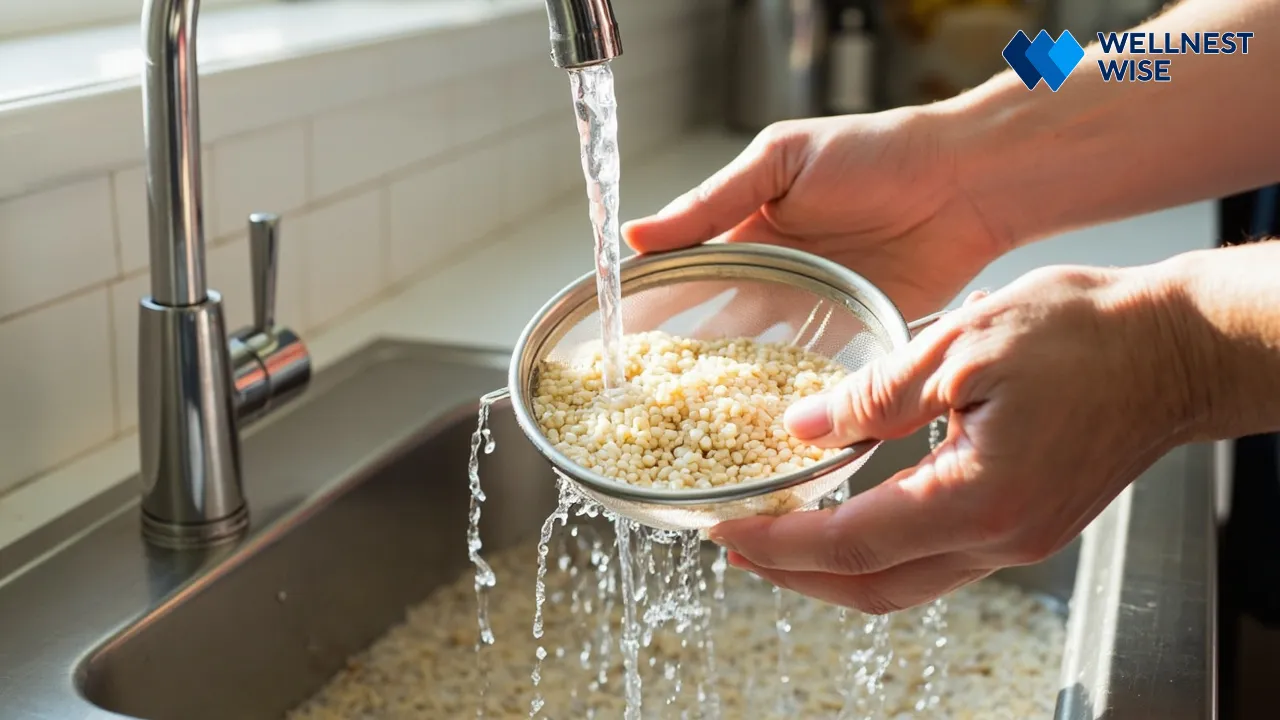
Essential Preparation: Why Rinsing Quinoa is Crucial for Flavor
Before cooking, an essential preparation step for quinoa is thorough rinsing. Quinoa seeds are naturally coated with saponins, a bitter, soap-like compound that serves as a natural defense mechanism against pests. If not removed, saponins can impart an unpleasant, bitter or soapy taste to your cooked quinoa, significantly detracting from its flavor. Simply place the raw quinoa in a fine-mesh sieve and rinse under cold running water for at least 30 seconds, or until the water runs clear. This quick but crucial step ensures a clean, palatable flavor that allows quinoa’s natural nutty taste to shine through [1].
Step-by-Step Guide: How to Properly Cook Quinoa on the Stovetop
Achieving perfectly fluffy and flavorful quinoa is easier than you think. Follow these clear, sequential steps for cooking it on the stovetop:
- Rinse Thoroughly: Place 1 cup of dry quinoa in a fine-mesh sieve and rinse under cold running water for 30 seconds to remove saponins.
- Combine Ingredients: Transfer the rinsed quinoa to a medium saucepan. Add 2 cups of water or vegetable broth. For added flavor, a pinch of salt can be included.
- Bring to a Boil: Bring the mixture to a rolling boil over medium-high heat.
- Reduce Heat & Simmer: Once boiling, reduce the heat to low, cover the saucepan tightly with a lid, and let it simmer for 15 minutes. Avoid lifting the lid during this time.
- Rest Off Heat: After 15 minutes, remove the saucepan from the heat, keeping the lid on, and let it rest for another 5-10 minutes. This allows the remaining steam to absorb and ensures a light, fluffy texture.
- Fluff and Serve: Remove the lid and use a fork to gently fluff the quinoa. You’ll notice the tiny “tail” — the germ of the grain — separating from the seed, indicating it’s perfectly cooked.
Common Cooking Mistakes and How to Avoid Them for Best Results
Even with a simple grain like quinoa, certain common cooking mistakes can derail your efforts. The most frequent issues include not rinsing thoroughly, which leads to bitterness, and using too much or too little water, resulting in either mushy or crunchy quinoa. Overcooking is another culprit, turning the grains soggy. To avoid them for best results: always rinse as the first step; adhere to the 1:2 quinoa-to-liquid ratio; use a tight-fitting lid during simmering; and resist the urge to peek during the cooking and resting phases. Patience and precision are your allies for perfectly cooked quinoa.
Achieving the Perfect Texture: Tips for Fluffy and Flavorful Quinoa
Beyond the basic cooking steps, a few expert tips for achieving the perfect texture can transform your quinoa. For an even nuttier flavor profile, consider toasting the dry, rinsed quinoa in a dry saucepan for 2-3 minutes before adding liquid. This enhances its natural aroma. Swapping water for low-sodium vegetable or chicken broth can infuse the quinoa with richer flavor. After fluffing, if you find it a bit too wet, simply spread it on a baking sheet for a few minutes to allow residual moisture to evaporate. These simple additions can make all the difference, ensuring your quinoa is consistently fluffy and flavorful.
Versatile Uses & Creative Quinoa Recipes for a Healthier Diet
The true brilliance of quinoa lies not just in its nutritional value, but in its incredible versatile uses in the kitchen. From hearty breakfasts to elegant dinners, this “mother of all grains” effortlessly integrates into countless dishes, making it simple to infuse your diet with its powerful health benefits. Exploring creative quinoa recipes can unlock new flavors and textures, proving that healthy eating doesn’t mean sacrificing deliciousness or culinary adventure. Let’s delve into how you can make quinoa a staple across all your meals.
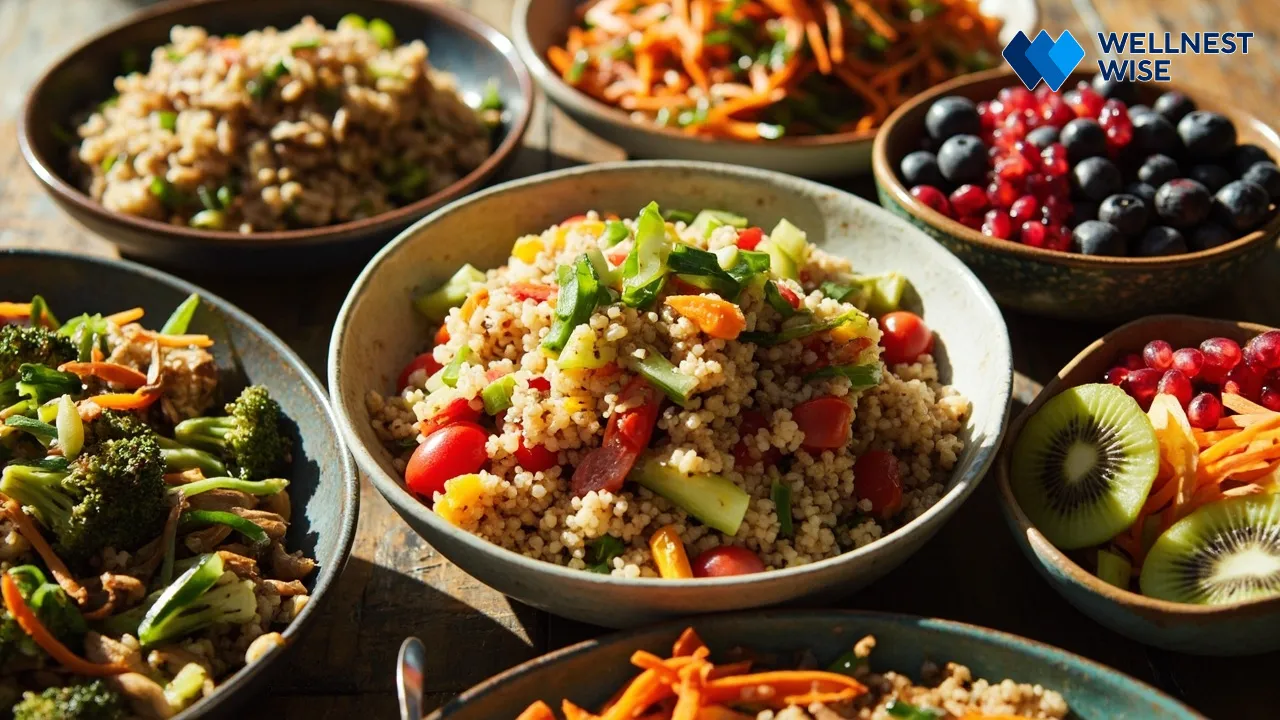
Quinoa for Breakfast: Energizing Starts to Your Day
Starting your day with quinoa can provide an energizing start due to its complex carbohydrates, complete protein, and fiber, ensuring sustained energy release and satiety. Beyond savory applications, it excels in sweet breakfast dishes, offering a nutritious alternative to traditional cereals.
Hearty Quinoa Porridge and Granola Alternatives
Transform your morning routine with a hearty quinoa porridge. Cooked with milk (dairy or plant-based) and simmered with cinnamon, fruit, and nuts, it’s a warm, comforting, and highly nutritious meal. You can also incorporate cooked quinoa into homemade granola recipes, baking it with oats, seeds, and dried fruits for a crunchy, granola alternative that’s rich in protein and fiber. This provides a customizable, wholesome option that keeps you feeling full and focused until lunch.
Elevating Salads: Adding Protein and Texture with Quinoa
Quinoa is a game-changer for elevating salads, transforming them from simple sides into complete, satisfying meals. Its slightly chewy texture and nutty flavor complement a wide array of vegetables, herbs, and dressings. By adding cooked quinoa, you instantly boost the protein and texture, making salads more substantial and nourishing. It absorbs flavors beautifully, acting as a perfect base for vibrant Mediterranean, Middle Eastern, or even simple green salads, providing a delightful contrast and an impressive nutritional punch.
Wholesome Main Dishes: Incorporating Quinoa as a Base or Side
As a neutral-flavored base or side, quinoa seamlessly integrates into virtually any wholesome main dish. It can replace rice, pasta, or potatoes, offering a more nutrient-dense accompaniment to roasted chicken, grilled fish, or vegetarian stews. Its ability to absorb flavors from broths and seasonings makes it incredibly versatile. Whether served alongside a rich Persian stew (like Gheymeh) or as the foundation for a Buddha bowl, quinoa adds substance and a complete protein profile, making your main meals more balanced and satisfying.
Plant-Based Quinoa Patties and Stuffed Vegetables
For creative plant-based options, quinoa shines in recipes like quinoa patties and stuffed vegetables. Combined with beans, herbs, and spices, cooked quinoa forms the perfect binder and texture for delicious veggie burgers or meatballs. Similarly, it’s an ideal filling for stuffed vegetables like bell peppers, zucchini, or tomatoes, mixed with other grains, legumes, and seasonings. These dishes are not only incredibly flavorful and satisfying but also provide a complete protein source, making them excellent choices for vegetarian and vegan diets.
Gluten-Free Baking and Snacks: Creative Ways to Use Quinoa Flour and Grains
Beyond whole grains, quinoa flour opens up a world of possibilities for gluten-free baking and snacks. Made from finely ground quinoa seeds, this flour offers a nutritious alternative for breads, muffins, pancakes, and cookies, providing a nutty flavor and boosting protein and fiber content in baked goods. You can also use cooked or puffed quinoa grains to make homemade energy bars, granola bars, or as a crunchy topping for yogurt and fruit, offering creative ways to use quinoa in your daily diet.
Quinoa in Specific Dietary Contexts and Key Considerations
While quinoa is widely celebrated for its nutritional benefits, understanding its fit within specific dietary contexts and acknowledging certain considerations is important. From its role as a cornerstone of plant-based diets to its implications for sustainable sourcing, a comprehensive view ensures that you can integrate quinoa into your lifestyle in the most effective and responsible way. Let’s explore how quinoa serves various dietary needs and what factors to keep in mind.

Quinoa as a Cornerstone of Plant-Based and Vegan Diets
For those following plant-based and vegan diets, quinoa emerges as an invaluable cornerstone. Its status as a complete protein, providing all nine essential amino acids, makes it a rare and vital resource in a diet that often requires careful pairing of plant proteins to ensure full amino acid intake. It effortlessly fills the protein gap that can sometimes be challenging for vegans, supporting muscle health, energy levels, and overall nutritional completeness. Its versatility allows it to replace animal-based proteins in a multitude of recipes, truly empowering plant-based eaters [2].
Fitting Quinoa into Weight Loss and Calorie-Controlled Diets
Quinoa is an excellent choice for weight loss and calorie-controlled diets due to its high fiber and protein content. These nutrients are known to promote satiety, helping individuals feel fuller for longer and potentially reducing overall calorie intake. While it is calorie-dense compared to some vegetables, its nutrient density means a smaller portion can deliver significant nutritional value. When replacing less nutrient-dense or refined grains, quinoa can contribute to a more balanced diet that supports weight management goals without sacrificing essential nutrients or feeling deprived.
Addressing Potential Sensitivities: Lectins, Saponins, and Digestive Comfort
While generally well-tolerated, some individuals may experience potential sensitivities to quinoa. The primary culprits are saponins, which are responsible for its bitter taste if not rinsed, and to a lesser extent, lectins. Saponins, though mostly removed by thorough rinsing, can sometimes cause mild digestive discomfort in very sensitive individuals. Lectins are natural plant compounds present in many foods (including legumes and grains) that can, in rare cases, irritate the gut lining, though their levels in quinoa are usually low and further reduced by cooking. If you experience unusual digestive discomfort, ensure proper rinsing and cooking, and consider starting with smaller portions to assess your tolerance [1].
Sustainable Sourcing: Understanding the Environmental and Ethical Aspects of Quinoa Production
As quinoa’s global popularity soared, so too did questions regarding its sustainable sourcing and ethical aspects of production. Historically a staple for Andean communities, the increased demand from wealthier nations led to price hikes, sometimes making it unaffordable for local populations who traditionally relied on it. This raises important considerations about fair trade, equitable compensation for farmers, and the environmental impact of large-scale mono-cropping versus traditional agro-ecological practices. Choosing ethically sourced or fair-trade certified quinoa can help ensure that its growing popularity benefits the original producers and promotes environmentally sound farming [3].
Frequently Asked Questions About Quinoa
Navigating the world of healthy eating often brings up many questions, and quinoa is no exception. As a unique and highly beneficial pseudocereal, common inquiries range from its carbohydrate profile to its role in fitness and how different varieties compare. We’ve compiled a list of practical, scientific Q&A to address the most common curiosities about quinoa, providing clear and concise answers to help you make informed dietary choices.

Is Quinoa Suitable for a Low-Carb Diet?
While quinoa offers numerous health benefits, it is not typically considered suitable for a very low-carb diet, such as a ketogenic diet. A 100g serving of cooked quinoa contains about 21 grams of carbohydrates, which is significantly higher than the carb allowance for strict low-carb plans. However, compared to refined grains, quinoa’s carbohydrates are complex, meaning they are digested slowly, and are balanced by its high fiber and protein content. For moderate carbohydrate diets, it’s an excellent choice for healthy, sustained energy.
Can Quinoa Help with Muscle Building and Recovery?
Absolutely. Quinoa is an excellent food for muscle building and recovery due to its status as a complete protein. It provides all nine essential amino acids necessary for muscle repair, growth, and synthesis, including lysine, which is often limited in other plant proteins. Its complex carbohydrates also replenish glycogen stores, providing energy for workouts and aiding post-exercise recovery. The minerals like magnesium further support muscle function and reduce cramping, making quinoa a highly effective food for athletes and active individuals.
What is the Difference Between White, Red, and Black Quinoa?
The primary difference between white, red, and black quinoa lies in their texture, slightly varying cook times, and subtle flavor profiles. White quinoa (the most common) is mildest in flavor and fluffiest when cooked. Red quinoa has a nuttier taste and retains a firmer, chewier texture, making it ideal for salads. Black quinoa is the earthiest and chewiest, also holding its shape well. Nutritionally, all three varieties are very similar, offering the same comprehensive benefits, so your choice can simply come down to aesthetic preference or desired texture in a dish.
Are There Any Side Effects to Eating Quinoa?
For most people, quinoa has no adverse side effects when prepared properly. The most common “side effect” is a bitter taste if the saponin coating is not thoroughly rinsed off before cooking. Some individuals with sensitive digestive systems might experience mild bloating or gas due to its high fiber content, especially if they are not accustomed to a high-fiber diet. Introducing quinoa gradually and ensuring proper hydration can help mitigate these issues. In rare cases, individuals with specific sensitivities to lectins might react, but this is uncommon and often reduced by cooking.
Embracing Quinoa for Sustainable Wellness and Culinary Exploration
As we’ve explored, quinoa is far more than just a trendy ingredient; it’s a nutritional powerhouse with deep historical roots and immense potential for modern diets. From its complete protein profile and rich fiber content to its array of essential vitamins, minerals, and potent antioxidants, it offers a holistic approach to wellness. Integrating quinoa into your meals can stabilize blood sugar, support digestive and heart health, aid in weight management, and provide a vital gluten-free, plant-based protein source.

Making Quinoa a Staple in Your Healthy Eating Journey
The journey to better health is often paved with conscious dietary choices. By understanding its benefits and mastering its simple preparation, you can confidently start making quinoa a staple in your healthy eating journey. Experiment with its different varieties, discover new recipes, and allow its versatility to inspire your culinary creativity. It’s a small change that can lead to significant improvements in your energy, digestion, and overall vitality.
Empowering Your Dietary Choices with Nutrient-Dense Ancient Grains
Ultimately, incorporating quinoa is about empowering your dietary choices with nutrient-dense ancient grains. It reminds us that often, the most impactful foods are those that have sustained humanity for centuries. By choosing quinoa, you’re not just selecting a healthy meal; you’re embracing a legacy of wellness, sustainability, and mindful eating that nourishes both your body and your planet. Start your quinoa adventure today and unlock a world of flavor and profound health benefits.








